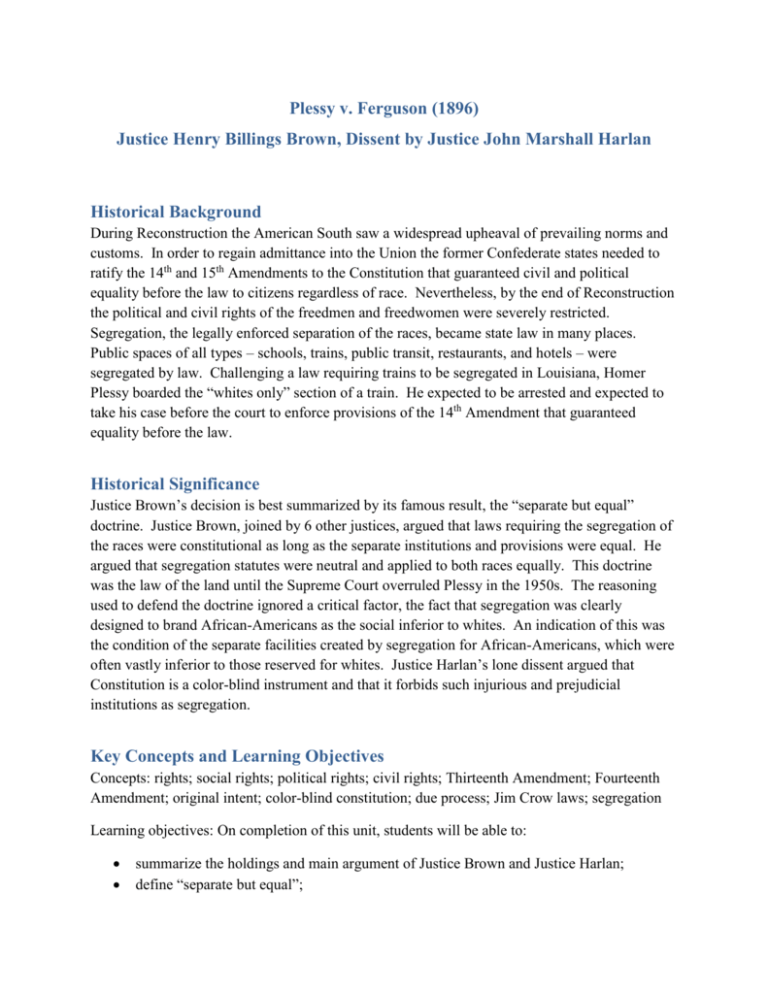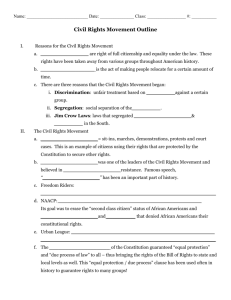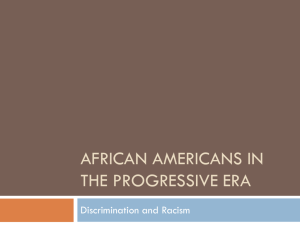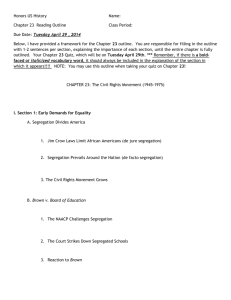Plessy v. Ferguson (1896)
advertisement

Plessy v. Ferguson (1896) Justice Henry Billings Brown, Dissent by Justice John Marshall Harlan Historical Background During Reconstruction the American South saw a widespread upheaval of prevailing norms and customs. In order to regain admittance into the Union the former Confederate states needed to ratify the 14th and 15th Amendments to the Constitution that guaranteed civil and political equality before the law to citizens regardless of race. Nevertheless, by the end of Reconstruction the political and civil rights of the freedmen and freedwomen were severely restricted. Segregation, the legally enforced separation of the races, became state law in many places. Public spaces of all types – schools, trains, public transit, restaurants, and hotels – were segregated by law. Challenging a law requiring trains to be segregated in Louisiana, Homer Plessy boarded the “whites only” section of a train. He expected to be arrested and expected to take his case before the court to enforce provisions of the 14th Amendment that guaranteed equality before the law. Historical Significance Justice Brown’s decision is best summarized by its famous result, the “separate but equal” doctrine. Justice Brown, joined by 6 other justices, argued that laws requiring the segregation of the races were constitutional as long as the separate institutions and provisions were equal. He argued that segregation statutes were neutral and applied to both races equally. This doctrine was the law of the land until the Supreme Court overruled Plessy in the 1950s. The reasoning used to defend the doctrine ignored a critical factor, the fact that segregation was clearly designed to brand African-Americans as the social inferior to whites. An indication of this was the condition of the separate facilities created by segregation for African-Americans, which were often vastly inferior to those reserved for whites. Justice Harlan’s lone dissent argued that Constitution is a color-blind instrument and that it forbids such injurious and prejudicial institutions as segregation. Key Concepts and Learning Objectives Concepts: rights; social rights; political rights; civil rights; Thirteenth Amendment; Fourteenth Amendment; original intent; color-blind constitution; due process; Jim Crow laws; segregation Learning objectives: On completion of this unit, students will be able to: summarize the holdings and main argument of Justice Brown and Justice Harlan; define “separate but equal”; define and describe “the color-blind Constitution”; define and describe the difference between “civil rights, political rights, and social rights”; summarize the 14th Amendment and decide whether Justice Harlan or Justice Brown correctly interpreted the 14th Amendment. Questions to Explore In his famous dissent Justice Harlan outlines his view of the “color-blind Constitution.” What are the benefits or drawbacks to interpreting the Constitution as “color-blind?” To what extent should color-blindness be considered a virtue? Explain your answer. In later striking down segregation, the court stressed the poor condition segregated facilities set aside for African-Americans. This raises a question: was the main problem with segregation these inferior facilities or is there a moral or ethical problem posed by segregation even with equal facilities? Many aspects of American society are still rather segregated by race, such as churches, neighborhoods and the like. Is there a substantial difference between this type of segregation and the type of segregation practiced in the past? If so, what is it? If not, why does it not generate the same type of response that legal segregation provoked during the Civil Rights Movement of the 1960s? Should it? How far should governments go in trying to make people less prejudiced and more fair? Should governments be content to ensure that they themselves treat everyone fairly? Should the laws reach into every area of life to ensure that people treat each other fairly? Or is there an intermediate position that makes sense? In the United States we have at least two significant levels of government, the federal and state governments. What would the ideal relationship between these two levels of government be? Which should be stronger? Which should define our political and civil rights?






